Hyundai H-1 (Grand Starex) 2011 Owner's Manual
Manufacturer: HYUNDAI, Model Year: 2011, Model line: H-1 (Grand Starex), Model: Hyundai H-1 (Grand Starex) 2011Pages: 338, PDF Size: 8.16 MB
Page 271 of 338
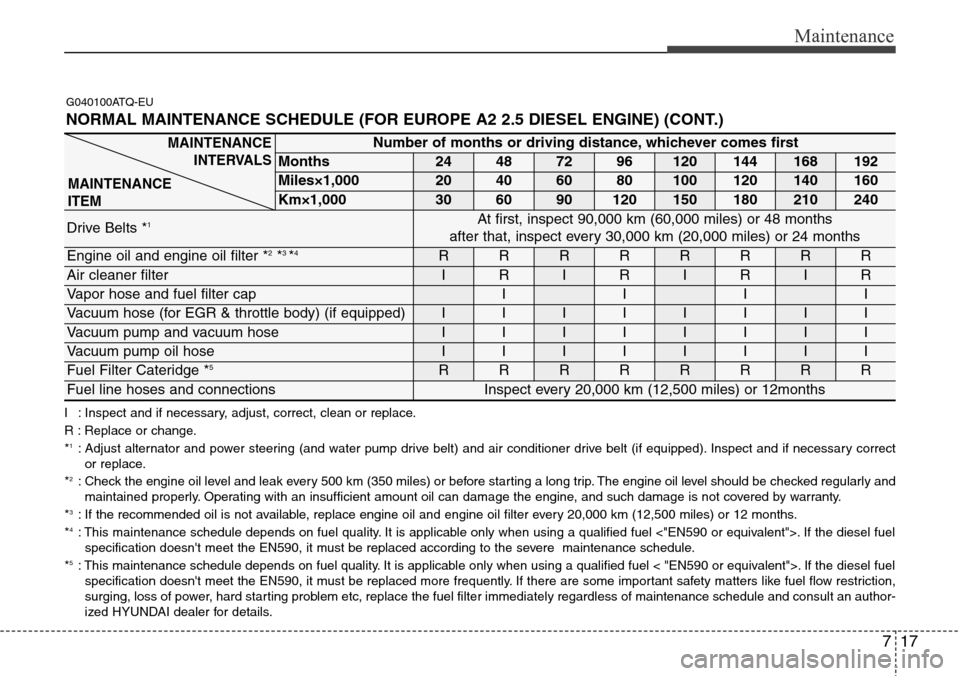
717
Maintenance
G040100ATQ-EU
NORMAL MAINTENANCE SCHEDULE (FOR EUROPE A2 2.5 DIESEL ENGINE) (CONT.)
I : Inspect and if necessary, adjust, correct, clean or replace.
R : Replace or change.
*
1: Adjust alternator and power steering (and water pump drive belt) and air conditioner drive belt (if equipped). Inspect and if necessary correct
or replace.
*
2: Check the engine oil level and leak every 500 km (350 miles) or before starting a long trip. The engine oil level should be checked regularly and
maintained properly. Operating with an insufficient amount oil can damage the engine, and such damage is not covered by warranty.
*
3: If the recommended oil is not available, replace engine oil and engine oil filter every 20,000 km (12,500 miles) or 12 months.
*4: This maintenance schedule depends on fuel quality. It is applicable only when using a qualified fuel <"EN590 or equivalent">. If the diesel fuel
specification doesn't meet the EN590, it must be replaced according to the severe maintenance schedule.
*
5: This maintenance schedule depends on fuel quality. It is applicable only when using a qualified fuel < "EN590 or equivalent">. If the diesel fuel
specification doesn't meet the EN590, it must be replaced more frequently. If there are some important safety matters like fuel flow restriction,
surging, loss of power, hard starting problem etc, replace the fuel filter immediately regardless of maintenance schedule and consult an author-
ized HYUNDAI dealer for details.
Number of months or driving distance, whichever comes first
Months24487296120144168192
Miles×1,00020406080100120140160
Km×1,000306090120150180210240
Drive Belts *1At first, inspect 90,000 km (60,000 miles) or 48 months
after that, inspect every 30,000 km (20,000 miles) or 24 months
Engine oil and engine oil filter *2*3 *4RRRRRRRR
Air cleaner filterIRIRIRIR
Vapor hose and fuel filter capIIII
Vacuum hose (for EGR & throttle body) (if equipped)IIIIIIII
Vacuum pump and vacuum hoseIIIIIIII
Vacuum pump oil hoseIIIIIIII
Fuel Filter Cateridge *5RRRRRRRR
Fuel line hoses and connectionsInspect every 20,000 km (12,500 miles) or 12months
MAINTENANCE
INTERVALS
MAINTENANCE
ITEM
Page 272 of 338
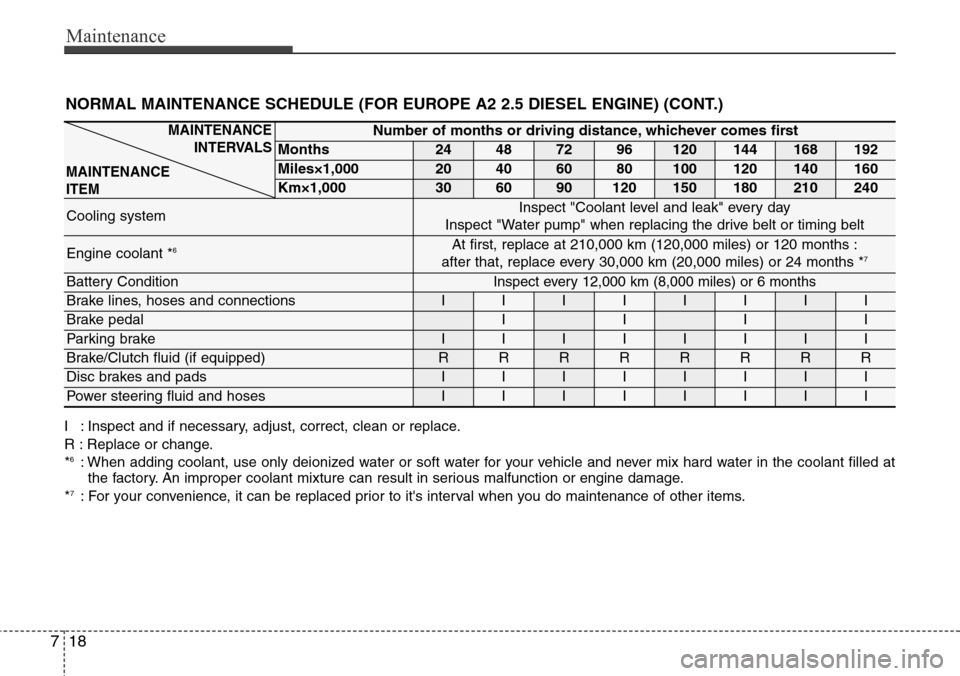
Maintenance
18 7
Number of months or driving distance, whichever comes first
Months24487296120144168192
Miles×1,00020406080100120140160
Km×1,000306090120150180210240
Cooling systemInspect "Coolant level and leak" every day
Inspect "Water pump" when replacing the drive belt or timing belt
Engine coolant *6At first, replace at 210,000 km (120,000 miles) or 120 months :
after that, replace every 30,000 km (20,000 miles) or 24 months *7
Battery ConditionInspect every 12,000 km (8,000 miles) or 6 months
Brake lines, hoses and connectionsIIIIIIII
Brake pedalIIII
Parking brakeIIIIIIII
Brake/Clutch fluid (if equipped)RRRRRRRR
Disc brakes and padsIIIIIIII
Power steering fluid and hosesIIIIIIII
NORMAL MAINTENANCE SCHEDULE (FOR EUROPE A2 2.5 DIESEL ENGINE) (CONT.)
I : Inspect and if necessary, adjust, correct, clean or replace.
R : Replace or change.
*
6: When adding coolant, use only deionized water or soft water for your vehicle and never mix hard water in the coolant filled at
the factory. An improper coolant mixture can result in serious malfunction or engine damage.
*
7: For your convenience, it can be replaced prior to it's interval when you do maintenance of other items.
MAINTENANCE
INTERVALS
MAINTENANCE
ITEM
Page 273 of 338
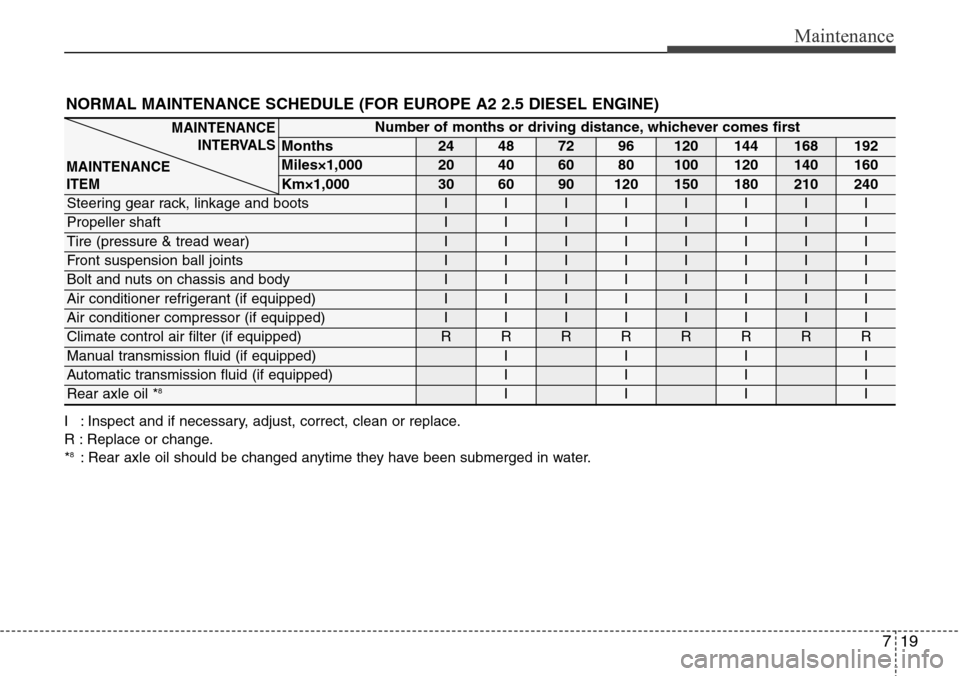
719
Maintenance
NORMAL MAINTENANCE SCHEDULE (FOR EUROPE A2 2.5 DIESEL ENGINE)
I : Inspect and if necessary, adjust, correct, clean or replace.
R : Replace or change.
*
8: Rear axle oil should be changed anytime they have been submerged in water.
Number of months or driving distance, whichever comes first
Months24487296120144168192
Miles×1,00020406080100120140160
Km×1,000306090120150180210240
Steering gear rack, linkage and bootsIIIIIIII
Propeller shaftIIIIIIII
Tire (pressure & tread wear)IIIIIIII
Front suspension ball jointsIIIIIIII
Bolt and nuts on chassis and bodyIIIIIIII
Air conditioner refrigerant (if equipped)IIIIIIII
Air conditioner compressor (if equipped)IIIIIIII
Climate control air filter (if equipped)RRRRRRRR
Manual transmission fluid (if equipped)IIII
Automatic transmission fluid (if equipped)IIII
Rear axle oil *8IIII
MAINTENANCE
INTERVALS
MAINTENANCE
ITEM
Page 274 of 338
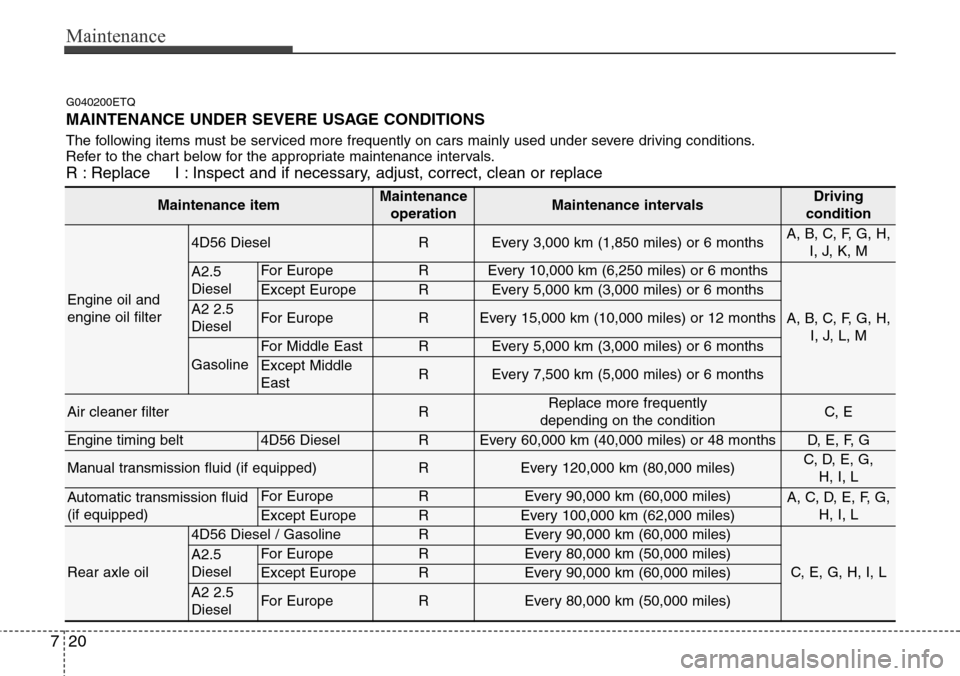
Maintenance
20 7
G040200ETQ
MAINTENANCE UNDER SEVERE USAGE CONDITIONS
The following items must be serviced more frequently on cars mainly used under severe driving conditions.
Refer to the chart below for the appropriate maintenance intervals.
R : Replace I : Inspect and if necessary, adjust, correct, clean or replace
Maintenance itemMaintenance
operationMaintenance intervalsDriving
condition
Engine oil and
engine oil filter
4D56 DieselREvery 3,000 km (1,850 miles) or 6 monthsA, B, C, F, G, H,
I, J, K, M
A2.5
Diesel For Europe REvery 10,000 km (6,250 miles) or 6 months
A, B, C, F, G, H,
I, J, L, M
Except EuropeREvery 5,000 km (3,000 miles) or 6 months
A2 2.5
Diesel For Europe REvery 15,000 km (10,000 miles) or 12 months
Gasoline
For Middle EastREvery 5,000 km (3,000 miles) or 6 months
Except Middle
EastREvery 7,500 km (5,000 miles) or 6 months
Air cleaner filterRReplace more frequently
depending on the conditionC, E
Engine timing belt4D56 Diesel REvery 60,000 km (40,000 miles) or 48 monthsD, E, F, G
Manual transmission fluid (if equipped)REvery 120,000 km (80,000 miles)C, D, E, G,
H, I, L
Automatic transmission fluid
(if equipped)For Europe REvery 90,000 km (60,000 miles)A, C, D, E, F, G,
H, I, L
Except EuropeREvery 100,000 km (62,000 miles)
Rear axle oil
4D56 Diesel / GasolineREvery 90,000 km (60,000 miles)
C, E, G, H, I, L
A2.5
Diesel For Europe REvery 80,000 km (50,000 miles)
Except EuropeREvery 90,000 km (60,000 miles)
A2 2.5
Diesel For Europe REvery 80,000 km (50,000 miles)
Page 275 of 338
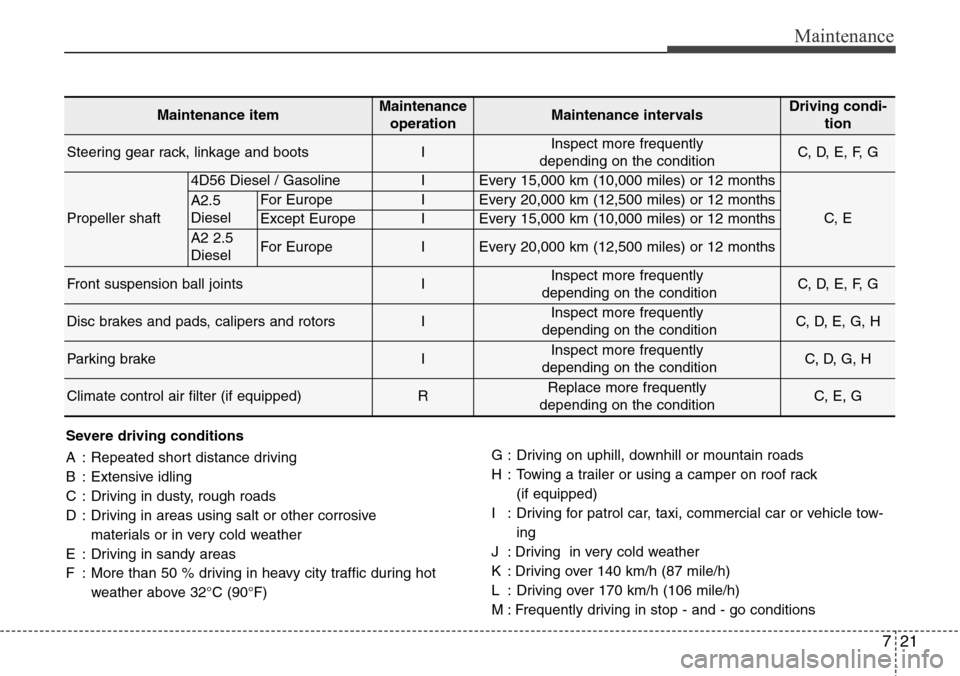
721
Maintenance
Severe driving conditions
A : Repeated short distance driving
B : Extensive idling
C : Driving in dusty, rough roads
D : Driving in areas using salt or other corrosive
materials or in very cold weather
E : Driving in sandy areas
F : More than 50 % driving in heavy city traffic during hot
weather above 32°C (90°F)G : Driving on uphill, downhill or mountain roads
H : Towing a trailer or using a camper on roof rack
(if equipped)
I : Driving for patrol car, taxi, commercial car or vehicle tow-
ing
J : Driving in very cold weather
K : Driving over 140 km/h (87 mile/h)
L : Driving over 170 km/h (106 mile/h)
M : Frequently driving in stop - and - go conditions
Maintenance itemMaintenance
operationMaintenance intervalsDriving condi-
tion
Steering gear rack, linkage and bootsIInspect more frequently
depending on the conditionC, D, E, F, G
Propeller shaft
4D56 Diesel / GasolineIEvery 15,000 km (10,000 miles) or 12 months
C, E
A2.5
Diesel For Europe IEvery 20,000 km (12,500 miles) or 12 months
Except EuropeIEvery 15,000 km (10,000 miles) or 12 months
A2 2.5
Diesel For Europe IEvery 20,000 km (12,500 miles) or 12 months
Front suspension ball jointsIInspect more frequently
depending on the conditionC, D, E, F, G
Disc brakes and pads, calipers and rotorsIInspect more frequently
depending on the conditionC, D, E, G, H
Parking brakeIInspect more frequently
depending on the conditionC, D, G, H
Climate control air filter (if equipped)RReplace more frequently
depending on the conditionC, E, G
Page 276 of 338
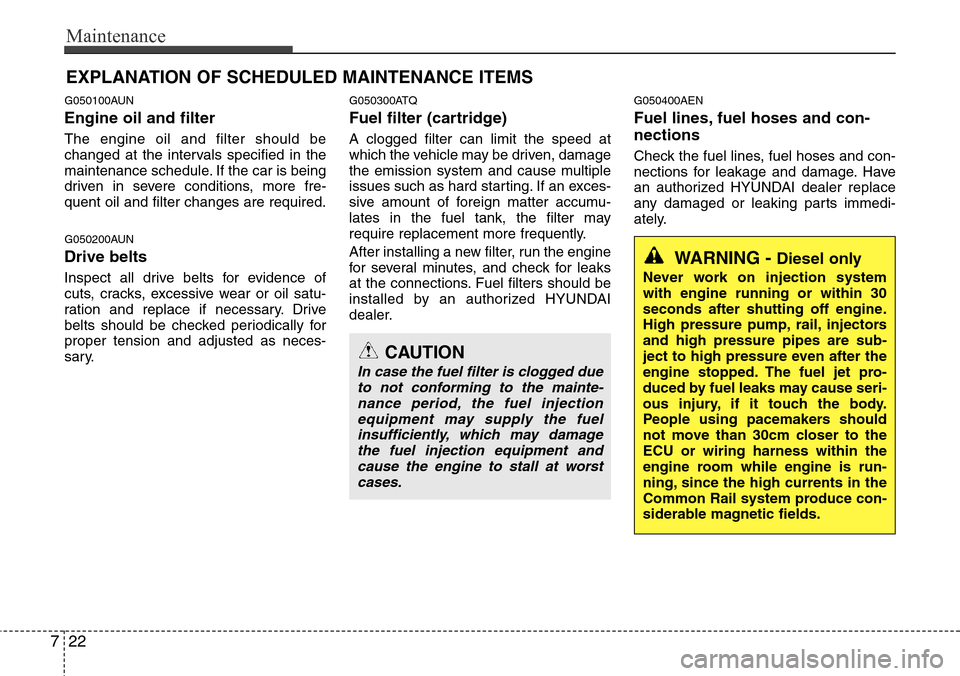
Maintenance
22 7
EXPLANATION OF SCHEDULED MAINTENANCE ITEMS
G050100AUN
Engine oil and filter
The engine oil and filter should be
changed at the intervals specified in the
maintenance schedule. If the car is being
driven in severe conditions, more fre-
quent oil and filter changes are required.
G050200AUN
Drive belts
Inspect all drive belts for evidence of
cuts, cracks, excessive wear or oil satu-
ration and replace if necessary. Drive
belts should be checked periodically for
proper tension and adjusted as neces-
sary.
G050300ATQ
Fuel filter (cartridge)
A clogged filter can limit the speed at
which the vehicle may be driven, damage
the emission system and cause multiple
issues such as hard starting. If an exces-
sive amount of foreign matter accumu-
lates in the fuel tank, the filter may
require replacement more frequently.
After installing a new filter, run the engine
for several minutes, and check for leaks
at the connections. Fuel filters should be
installed by an authorized HYUNDAI
dealer.
G050400AEN
Fuel lines, fuel hoses and con-
nections
Check the fuel lines, fuel hoses and con-
nections for leakage and damage. Have
an authorized HYUNDAI dealer replace
any damaged or leaking parts immedi-
ately.
WARNING - Diesel only
Never work on injection system
with engine running or within 30
seconds after shutting off engine.
High pressure pump, rail, injectors
and high pressure pipes are sub-
ject to high pressure even after the
engine stopped. The fuel jet pro-
duced by fuel leaks may cause seri-
ous injury, if it touch the body.
People using pacemakers should
not move than 30cm closer to the
ECU or wiring harness within the
engine room while engine is run-
ning, since the high currents in the
Common Rail system produce con-
siderable magnetic fields.
CAUTION
In case the fuel filter is clogged due
to not conforming to the mainte-
nance period, the fuel injection
equipment may supply the fuel
insufficiently, which may damage
the fuel injection equipment and
cause the engine to stall at worst
cases.
Page 277 of 338
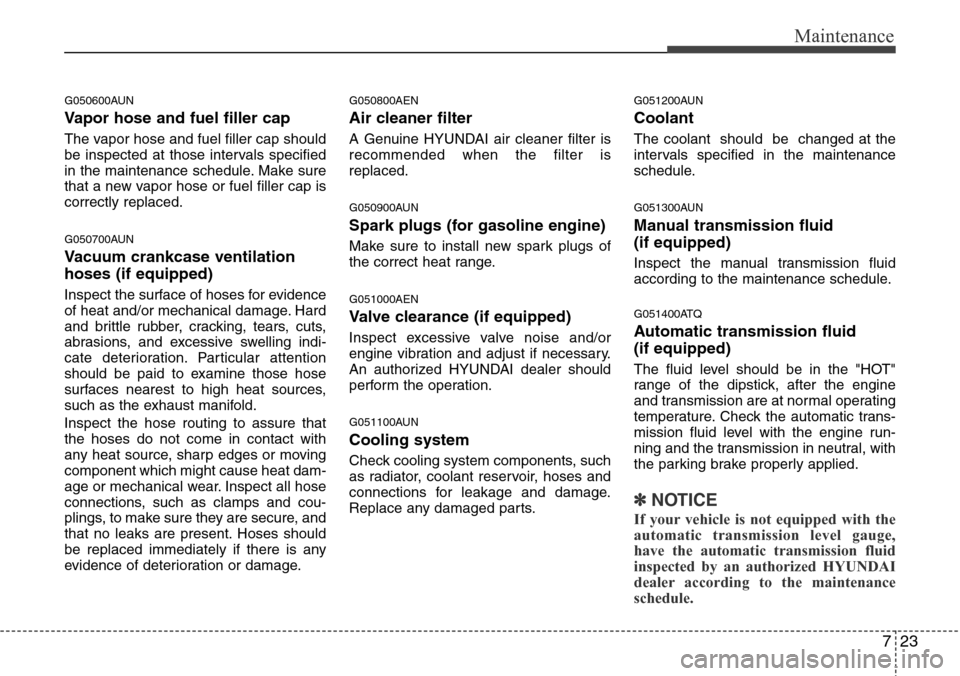
723
Maintenance
G050600AUN
Vapor hose and fuel filler cap
The vapor hose and fuel filler cap should
be inspected at those intervals specified
in the maintenance schedule. Make sure
that a new vapor hose or fuel filler cap is
correctly replaced.
G050700AUN
Vacuum crankcase ventilation
hoses (if equipped)
Inspect the surface of hoses for evidence
of heat and/or mechanical damage. Hard
and brittle rubber, cracking, tears, cuts,
abrasions, and excessive swelling indi-
cate deterioration. Particular attention
should be paid to examine those hose
surfaces nearest to high heat sources,
such as the exhaust manifold.
Inspect the hose routing to assure that
the hoses do not come in contact with
any heat source, sharp edges or moving
component which might cause heat dam-
age or mechanical wear. Inspect all hose
connections, such as clamps and cou-
plings, to make sure they are secure, and
that no leaks are present. Hoses should
be replaced immediately if there is any
evidence of deterioration or damage.
G050800AEN
Air cleaner filter
A Genuine HYUNDAI air cleaner filter is
recommended when the filter is
replaced.
G050900AUN
Spark plugs (for gasoline engine)
Make sure to install new spark plugs of
the correct heat range.
G051000AEN
Valve clearance (if equipped)
Inspect excessive valve noise and/or
engine vibration and adjust if necessary.
An authorized HYUNDAI dealer should
perform the operation.
G051100AUN
Cooling system
Check cooling system components, such
as radiator, coolant reservoir, hoses and
connections for leakage and damage.
Replace any damaged parts.
G051200AUN
Coolant
The coolant should be changed at the
intervals specified in the maintenance
schedule.
G051300AUN
Manual transmission fluid
(if equipped)
Inspect the manual transmission fluid
according to the maintenance schedule.
G051400ATQ
Automatic transmission fluid
(if equipped)
The fluid level should be in the "HOT"
range of the dipstick, after the engine
and transmission are at normal operating
temperature. Check the automatic trans-
mission fluid level with the engine run-
ning and the transmission in neutral, with
the parking brake properly applied.
✽NOTICE
If your vehicle is not equipped with the
automatic transmission level gauge,
have the automatic transmission fluid
inspected by an authorized HYUNDAI
dealer according to the maintenance
schedule.
Page 278 of 338
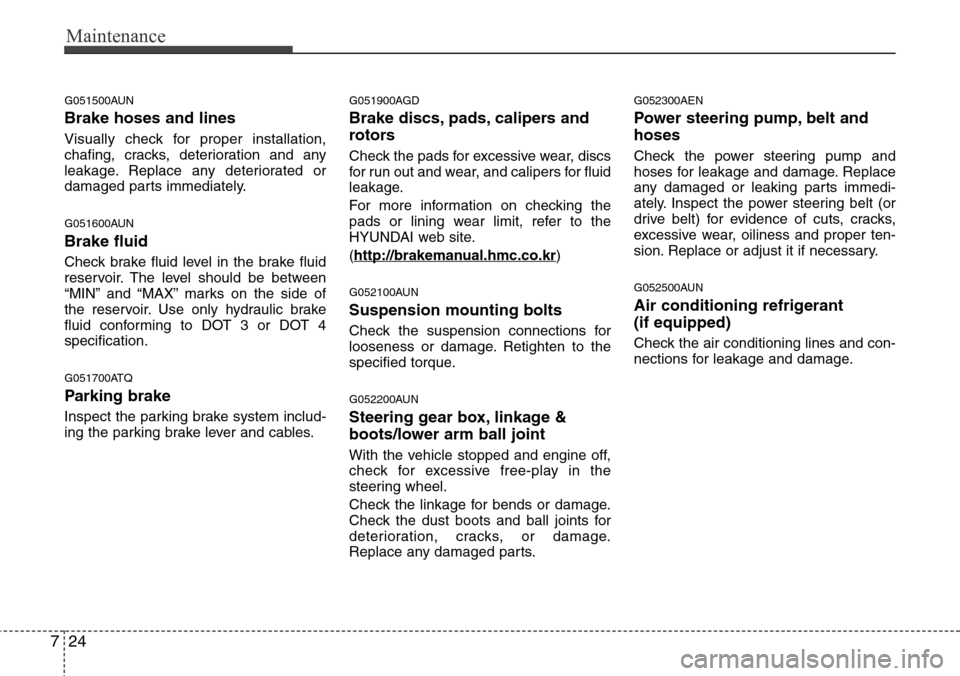
Maintenance
24 7
G051500AUN
Brake hoses and lines
Visually check for proper installation,
chafing, cracks, deterioration and any
leakage. Replace any deteriorated or
damaged parts immediately.
G051600AUN
Brake fluid
Check brake fluid level in the brake fluid
reservoir. The level should be between
“MIN” and “MAX” marks on the side of
the reservoir. Use only hydraulic brake
fluid conforming to DOT 3 or DOT 4
specification.
G051700ATQ
Parking brake
Inspect the parking brake system includ-
ing the parking brake lever and cables.
G051900AGD
Brake discs, pads, calipers and
rotors
Check the pads for excessive wear, discs
for run out and wear, and calipers for fluid
leakage.
For more information on checking the
pads or lining wear limit, refer to the
HYUNDAI web site.
(http://brakeman
ual.hmc.co.kr)
G052100AUN
Suspension mounting bolts
Check the suspension connections for
looseness or damage. Retighten to the
specified torque.
G052200AUN
Steering gear box, linkage &
boots/lower arm ball joint
With the vehicle stopped and engine off,
check for excessive free-play in the
steering wheel.
Check the linkage for bends or damage.
Check the dust boots and ball joints for
deterioration, cracks, or damage.
Replace any damaged parts.
G052300AEN
Power steering pump, belt and
hoses
Check the power steering pump and
hoses for leakage and damage. Replace
any damaged or leaking parts immedi-
ately. Inspect the power steering belt (or
drive belt) for evidence of cuts, cracks,
excessive wear, oiliness and proper ten-
sion. Replace or adjust it if necessary.
G052500AUN
Air conditioning refrigerant
(if equipped)
Check the air conditioning lines and con-
nections for leakage and damage.
Page 279 of 338
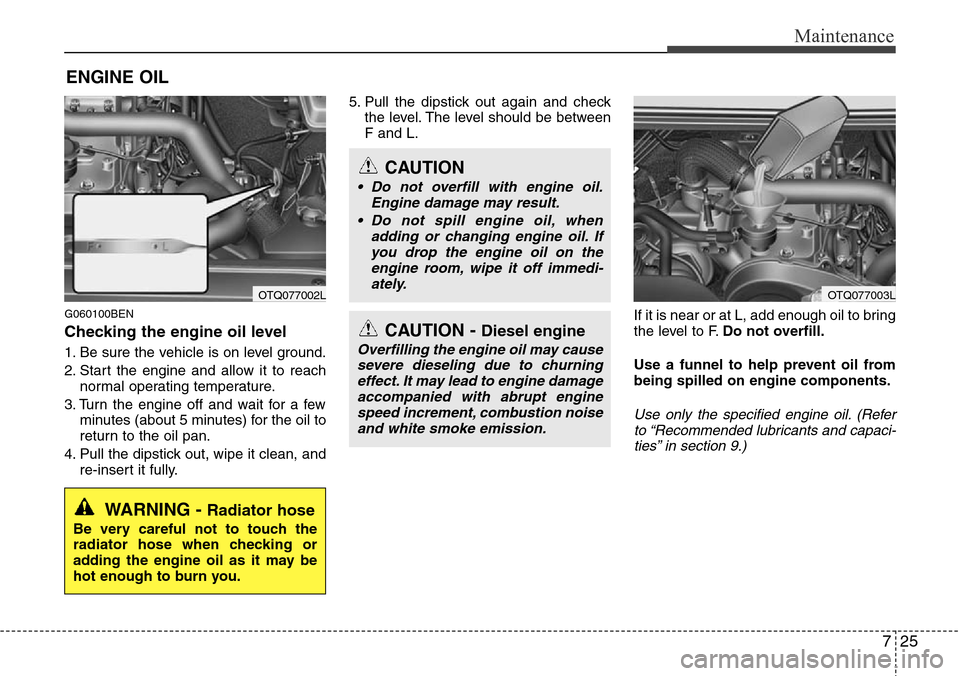
725
Maintenance
ENGINE OIL
G060100BEN
Checking the engine oil level
1. Be sure the vehicle is on level ground.
2. Start the engine and allow it to reach
normal operating temperature.
3. Turn the engine off and wait for a few
minutes (about 5 minutes) for the oil to
return to the oil pan.
4. Pull the dipstick out, wipe it clean, and
re-insert it fully.5. Pull the dipstick out again and check
the level. The level should be between
F and L.
If it is near or at L, add enough oil to bring
the level to F.Do not overfill.
Use a funnel to help prevent oil from
being spilled on engine components.
Use only the specified engine oil. (Refer
to “Recommended lubricants and capaci-
ties” in section 9.)
WARNING - Radiator hose
Be very careful not to touch the
radiator hose when checking or
adding the engine oil as it may be
hot enough to burn you.
OTQ077002LOTQ077003L
CAUTION - Diesel engine
Overfilling the engine oil may cause
severe dieseling due to churning
effect. It may lead to engine damage
accompanied with abrupt engine
speed increment, combustion noise
and white smoke emission.
CAUTION
• Do not overfill with engine oil.
Engine damage may result.
• Do not spill engine oil, when
adding or changing engine oil. If
you drop the engine oil on the
engine room, wipe it off immedi-
ately.
Page 280 of 338
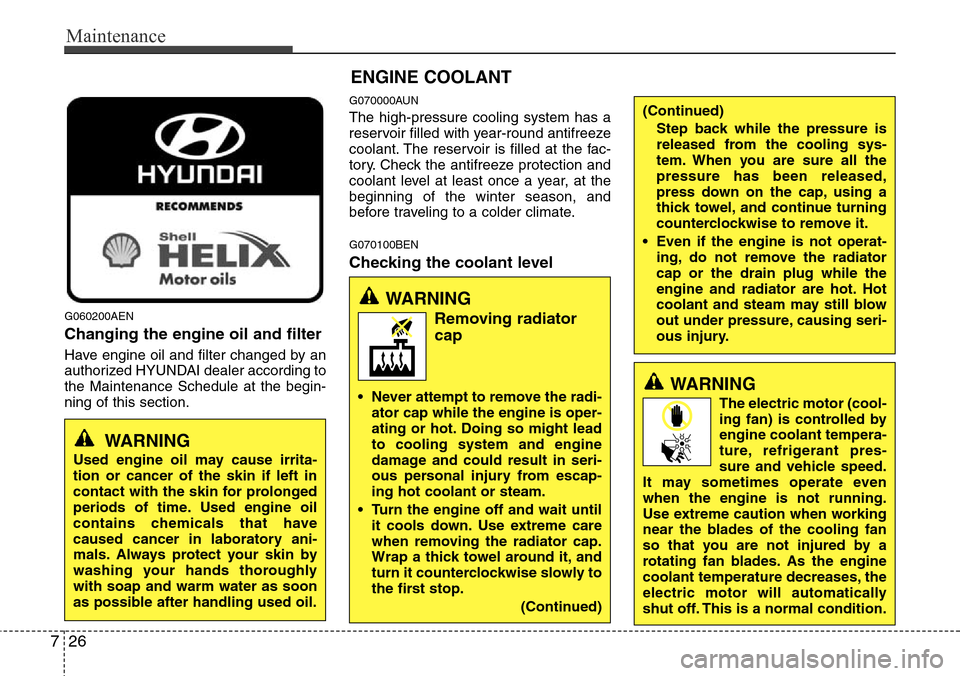
Maintenance
26 7
G060200AEN
Changing the engine oil and filter
Have engine oil and filter changed by an
authorized HYUNDAI dealer according to
the Maintenance Schedule at the begin-
ning of this section.
G070000AUN
The high-pressure cooling system has a
reservoir filled with year-round antifreeze
coolant. The reservoir is filled at the fac-
tory. Check the antifreeze protection and
coolant level at least once a year, at the
beginning of the winter season, and
before traveling to a colder climate.
G070100BEN
Checking the coolant level
WARNING
Used engine oil may cause irrita-
tion or cancer of the skin if left in
contact with the skin for prolonged
periods of time. Used engine oil
contains chemicals that have
caused cancer in laboratory ani-
mals. Always protect your skin by
washing your hands thoroughly
with soap and warm water as soon
as possible after handling used oil.
ENGINE COOLANT
WARNING
The electric motor (cool-
ing fan) is controlled by
engine coolant tempera-
ture, refrigerant pres-
sure and vehicle speed.
It may sometimes operate even
when the engine is not running.
Use extreme caution when working
near the blades of the cooling fan
so that you are not injured by a
rotating fan blades. As the engine
coolant temperature decreases, the
electric motor will automatically
shut off. This is a normal condition.
(Continued)
Step back while the pressure is
released from the cooling sys-
tem. When you are sure all the
pressure has been released,
press down on the cap, using a
thick towel, and continue turning
counterclockwise to remove it.
• Even if the engine is not operat-
ing, do not remove the radiator
cap or the drain plug while the
engine and radiator are hot. Hot
coolant and steam may still blow
out under pressure, causing seri-
ous injury.
WARNING
Removing radiator
cap
• Never attempt to remove the radi-
ator cap while the engine is oper-
ating or hot. Doing so might lead
to cooling system and engine
damage and could result in seri-
ous personal injury from escap-
ing hot coolant or steam.
• Turn the engine off and wait until
it cools down. Use extreme care
when removing the radiator cap.
Wrap a thick towel around it, and
turn it counterclockwise slowly to
the first stop.
(Continued)